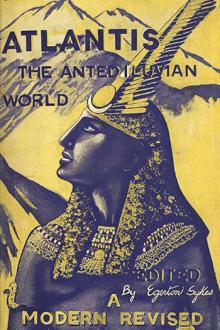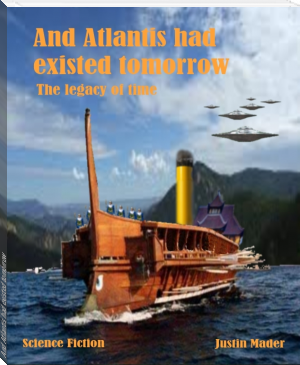Atlantis: The Antedeluvian World by Ignatius Donnelly (thriller novels to read .TXT) 📕

- Author: Ignatius Donnelly
- Performer: -
Book online «Atlantis: The Antedeluvian World by Ignatius Donnelly (thriller novels to read .TXT) 📕». Author Ignatius Donnelly
It may be said that it is improbable that the use of an alphabet could have ascended to antediluvian times, or to that prehistoric age when intercourse existed between ancient Europe and America; but it must be remembered that if the Flood legends of Europe and Asia are worth anything they prove that the art of writing existed at the date of the Deluge, and that records of antediluvian learning were preserved by those who escaped the Flood; while Plato tells us that the people of Atlantis engraved their laws upon columns of bronze and plates of gold.
There was a general belief among the ancient nations that the art of writing was known to the antediluvians. The Druids believed in books more ancient than the Flood. They styled them “the books of Pheryllt,”
and “the writings of Pridian or Hu.” “Ceridwen consults them before she prepares the mysterious caldron which shadows out the awful catastrophe of the Deluge.” (Faber’s “Pagan Idolatry,” vol. ii., pp. 150, 151.) In the first Avatar of Vishnu we are told that “the divine ordinances were stolen by the demon Haya-Griva. Vishnu became a fish; and after the Deluge, when the waters had subsided, he recovered the holy books from the bottom of the ocean.” Berosus, speaking of the time before the Deluge, says: “Oannes wrote concerning the generations of mankind and their civil polity.” The Hebrew commentators on Genesis say, “Our rabbins assert that Adam, our father of blessed memory, composed a book of precepts, which were delivered to him by God in Paradise.” (Smith’s “Sacred Annals,” p. 49.) That is to say, the Hebrews preserved a tradition that the Ad-ami, the people of Ad, or Adlantis, possessed, while yet dwelling in Paradise, the art of writing. It has been suggested that without the use of letters it would have been impossible to preserve the many details as to dates, ages, and measurements, as of the ark, handed down to us in Genesis. Josephus, quoting Jewish traditions, says, “The births and deaths of illustrious men, between Adam and Noah, were noted down at the time with great accuracy.” (Ant., lib. 1, cap. iii., see. 3.) Suidas, a Greek lexicographer of the eleventh century, expresses tradition when he says, “Adam was the author of arts and letters.” The Egyptians said that their god Anubis was an antediluvian, and it “wrote annals before the Flood.” The Chinese have traditions that the earliest race of their nation, prior to history, “taught all the arts of life and wrote books.” “The Goths always had the use of letters;” and Le Grand affirms that before or soon after the Flood “there were found the acts of great men engraved in letters on large stones.” (Fosbroke’s “Encyclopædia of Antiquity,” vol. i., p.
355.) Pliny says, “Letters were always in use.” Strabo says, “The inhabitants of Spain possessed records written before the Deluge.”
(Jackson’s “Chronicles of Antiquity,” vol. iii., p. 85.) Mitford (“History of Greece,” vol. i, p. 121) says, “Nothing appears to us so probable as that it (the alphabet) was derived from the antediluvian world.”
CHAPTER VIII.
THE BRONZE AGE IN EUROPE.
There exist in Europe the evidences of three different ages of human development:
1. The Stone Age, which dates back to a vast antiquity. It is subdivided into two periods: an age of rough stone implements; and a later age, when these implements were ground smooth and made in improved forms.
2. The Bronze Age, when the great mass of implements were manufactured of a compound metal, consisting of about nine parts of copper and one part of tin.
3. An age when iron superseded bronze for weapons and cutting tools, although bronze still remained in use for ornaments. This age continued down to what we call the Historical Period, and embraces our present civilization; its more ancient remains are mixed with coins of the Gauls, Greeks, and Romans.
The Bronze Period has been one of the perplexing problems of European scientists. Articles of bronze are found over nearly all that continent, but in especial abundance in Ireland and Scandinavia. They indicate very considerable refinement and civilization upon the part of the people who made them; and a wide diversity of opinion has prevailed as to who that people were and where they dwelt.
In the first place, it was observed that the age of bronze (a compound of copper and tin) must, in the natural order of things, have been preceded by an age when copper and tin were used separately, before the ancient metallurgists had discovered the art of combining them, and yet in Europe the remains of no such age have been found. Sir John Lubbock says (“Prehistoric Times,” p. 59), “The absence of implements made either of copper or tin seems to me to indicate that the art of making bronze was introduced into, not invented in, Europe.” The absence of articles of copper is especially marked, nearly all the European specimens of copper implements have been found in Ireland; and yet out of twelve hundred and eighty-three articles of the Bronze Age, in the great museum at Dublin, only thirty celts and one sword-blade are said to be made of pure copper; and even as to some of these there seems to be a question.
Where on the face of the earth are we to find a Copper Age? Is it in the barbaric depths of that Asia out of whose uncivilized tribes all civilization is said to have issued? By no means. Again we are compelled to turn to the West. In America, from Bolivia to Lake Superior, we find everywhere the traces of a long-enduring Copper Age; bronze existed, it is true, in Mexico, but it held the same relation to the copper as the copper held to the bronze in Europe—it was the exception as against the rule. And among the Chippeways of the shores of Lake Superior, and among them alone, we find any traditions of the origin of the manufacture of copper implements; and on the shores of that lake we find pure copper, out of which the first metal tools were probably hammered before man had learned to reduce the ore or run the metal into moulds. And on the shores of this same American lake we find the ancient mines from which some people, thousands of years ago, derived their supplies of copper.
IMPLEMENTS AND ORNAMENTS OF THE BRONZE AGESir W. R. Wilde says, “It is remarkable that so few antique copper implements have been found (in Europe), although a knowledge of that metal must have been the preliminary stage in the manufacture of bronze.” He thinks that this may be accounted for by supposing that “but a short time elapsed between the knowledge of smelting and casting copper ore and the introduction of tin, and the subsequent manufacture and use of bronze.”
But here we have in America the evidence that thousands of years must have elapsed during which copper was used alone, before it was discovered that by adding one-tenth part of tin it gave a harder edge, and produced a superior metal.
The Bronze Age cannot be attributed to the Roman civilization. Sir John Lubbock shows (“Prehistoric Times,” p. 21) that bronze weapons have never been found associated with Roman coins or pottery, or other remains of the Roman Period; that bronze articles have been found in the greatest abundance in countries like Ireland and Denmark, which were never invaded by Roman armies; and that the character of the ornamentation of the works of bronze is not Roman in character, and that the Roman bronze contained a large proportion of lead, which is never the case in that of the Bronze Age.
It has been customary to assume that the Bronze Age was due to the Phœnicians, but of late the highest authorities have taken issue with this opinion. Sir John Lubbock (Ibid., p. 73) gives the following reasons why the Phœnicians could not have been the authors of the Bronze Age: First, the ornamentation is different. In the Bronze Age “this always consists of geometrical figures, and we rarely, if ever, find upon them representations of animals and plants, while on the ornamented shields, etc., described by Homer, as well as in the decoration of Solomon’s Temple, animals and plants were abundantly represented.” The cuts on p. 242 will show the character of the ornamentation of the Bronze Age. In the next place, the form of burial is different in the Bronze Age from that of the Phœnicians. “In the third place, the Phœnicians, so far as we know them, were well acquainted with the use of iron; in Homer we find the warriors already armed with iron weapons, and the tools used in preparing the materials for Solomon’s Temple were of this metal.”
This view is also held by M. de Fallenberg, in the “Bulletin de la Société des Sciences” of Berne. (See “Smithsonian Rep.,” 1865-66, p.
383.) He says,
ORNAMENTS OF THE BRONZE AGE“It seems surprising that the nearest neighbors of the Phœnicians—the Greeks, the Egyptians, the Etruscans, and the Romans—should have manufactured plumbiferous bronzes, while the Phœnicians carried to the people of the North only pure bronzes without the alloy of lead. If the civilized people of the Mediterranean added lead to their bronzes, it can scarcely be doubted that the calculating Phœnicians would have done as much, and, at least, with distant and half-civilized tribes, have replaced the more costly tin by the cheaper metal. . . . On the whole, then, I consider that the first knowledge of bronze may have been conveyed to the populations of the period tinder review not only by the Phœnicians, but by other civilized people dwelling more to the south-east.”
Professor E. Desor, in his work on the “Lacustrian Constructions of the Lake of Neuchatel,” says,
“The Phœnicians certainly knew the use of iron, and it can scarcely be conceived why they should have excluded it from their commerce on the Scandinavian coasts. . . . The Etruscans, moreover, were acquainted with the use of iron as well as the Phœnicians, and it has already been seen that the composition of their bronzes is different, since it contains lead, which is entirely a stranger to our bronze epoch. . . . We must look, then, beyond both the Etruscans and Phœnicians in attempting to identify the commerce of the Bronze Age of our palafittes. It will be the province of the historian to inquire whether, exclusive of





Comments (0)